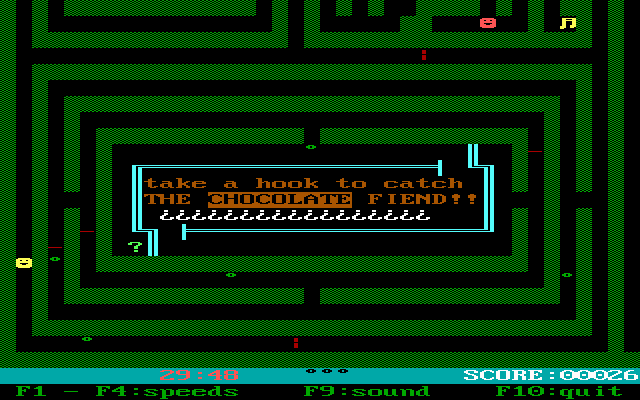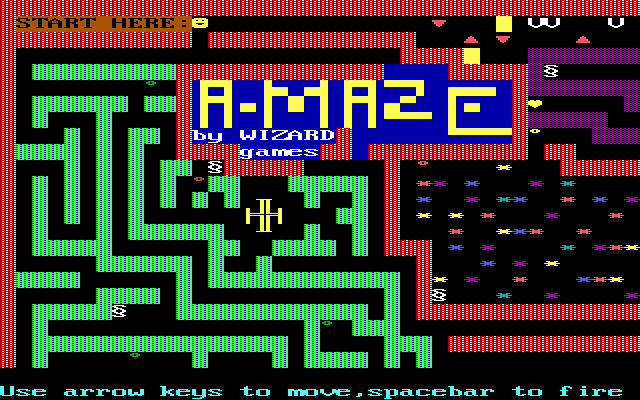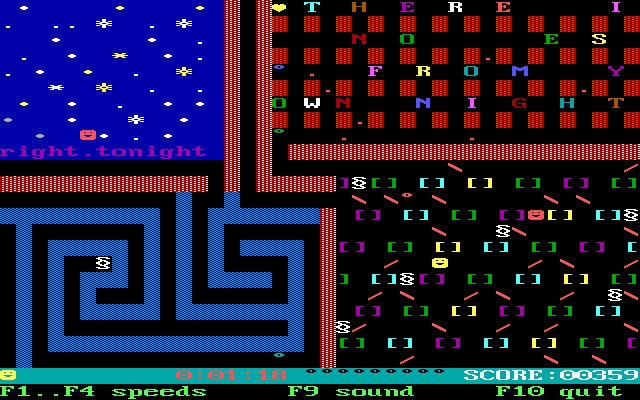Retro Replay Review
Gameplay
Amaze thrusts players into a relentless, textmode labyrinth that demands quick thinking and constant vigilance. You control a roguelike yellow happy face navigating corridors filled with endlessly respawning red-face foes, finite ammunition, health bonuses, and a host of abstract ASCII dangers. The core loop revolves around exploration, resource management, and tactical movement—every step could spell either success or a swift game over.
The pacing in Amaze is brisk; enemies follow real-time routines reminiscent of classic Kroz-style designs, which means there’s no hiding behind static obstacles for long. Ammo refills and health bonuses provide momentary relief, but since supplies are scarce, players must balance aggressive clearing of rooms with cautious preservation of resources. The lack of a clear map forces you to build mental representations of each segment, heightening both tension and satisfaction when you finally link corridors together.
Procedurally, each segment of the maze features a different colour scheme and obstacle set, so memorization becomes an evolving challenge. Sometimes messages are spelled out plainly in the room layout, breaking the fourth wall to address the player directly, adding a meta layer to the exploration. These messages can be cryptic hints or merely playful taunts—either way, they deepen the sense of immersion in this strange, ASCII-defined world.
For those who crave roguelike difficulty, Amaze delivers in spades. Death here is swift and often feels inevitable, especially when a horde of red faces corners you in a narrow corridor. The game’s shareware iteration, Insanity, only increases this tension by booting you after a single death, further underscoring how every decision matters. If you revel in trial-and-error progression and learning through repeated failure, Amaze will keep you coming back for more.
Graphics
Visually, Amaze is pure retro charm, presented entirely in textmode with a variety of ASCII characters serving as walls, enemies, and environmental hazards. Each maze segment boasts its own distinct colour palette, ranging from soothing pastels to harsh, strobing contrasts. This variety helps players distinguish between levels at a glance, preventing the text-based visuals from ever feeling stale.
The choice of ASCII art isn’t just nostalgia for nostalgia’s sake—it’s integral to the game’s identity. Characters like the yellow and red faces, weapon icons, and the cryptic symbols that hint at hidden dangers are all designed with minimal lines but maximum clarity. While these visuals won’t win any awards for polygon count or texture fidelity, they excel at conveying information efficiently, which is crucial in a game where split-second reactions can save your run.
Subtle animations, such as the blinking of enemies or the flicker of colour transitions between screens, add a surprising amount of life to what could otherwise be static levels. In the Insanity version, extra “flashes and bleeps” accompany these transitions, giving each new room introduction an arcade-like flourish. These audiovisual cues not only serve to entertain, but also signal important gameplay moments—like the arrival of tougher foes or the depletion of ammunition.
Overall, Amaze’s graphical presentation is a masterclass in doing more with less. By leaning into the limitations of textmode, the developers have crafted an environment that’s both functional and evocative. Players seeking high-definition shaders and ultra-realistic lighting will need to adjust their expectations, but anyone open to retro-inspired minimalism will find this aesthetic deeply satisfying.
Story
At its core, Amaze offers a minimalist narrative that shines through environmental storytelling and occasional in-game messages. You play as a yellow happy face dropped into an enormous, multi-segmented labyrinth for reasons unknown. There’s no cutscene exposition or lengthy dialogue—just you, the maze, and the arcane symbols that hint at hidden perils.
The cryptic messages sometimes spelled out in the layout break the monotony of pure puzzle-solving and introduce a playful, meta commentary on the nature of games and player agency. One moment you might find a reassuring “You can do it!” spelled out in characters, and the next you’re confronted with something like “Why bother?” etched into the walls. These moments of personality give life to an otherwise abstract setting.
Insanity’s shareware release introduces new objects and puzzle elements that suggest a deeper adventure-game layer, hinting at puzzles beyond mere maze traversal and combat. While the full extent of this expanded narrative remains locked behind repeated playthroughs, these additions raise intriguing questions: Who built the maze? Is there a way out? And what awaits beyond the next corridor? The game never hands you clear answers, inviting you to piece together the story yourself.
In the end, the narrative in Amaze is less about a structured plot and more about the experience of exploration and discovery. The absence of explicit lore pushes players to interpret the willy-nilly ASCII symbols and enigmatic warnings, making every unlocked secret feel like a personal achievement. If you enjoy emergent storytelling that you uncover through gameplay rather than cutscenes, Amaze delivers an experience that’s as memorable as it is mysterious.
Overall Experience
Amaze excels at delivering a compact yet profoundly challenging roguelike maze adventure. Its quick restarts, varied colour schemes, and relentless enemy respawns ensure that no two runs feel exactly alike. Each session is a test of your spatial memory, resource management, and adaptability, keeping you on edge from the very first screen to the last.
The minimalist audio in the base game (“bleeps and bloops”) and the enhanced sound effects in Insanity complement the textmode visuals without ever overwhelming the senses. Combined with the fleeting on-screen messages, they contribute to an atmosphere that’s equal parts nostalgic and unnerving. You never know when a sudden flash or a cryptic warning will disrupt your carefully plotted route, which injects every moment with tension.
Replayability is where Amaze truly shines. The finite resources, permadeath mechanics, and randomized segment layouts mean that each playthrough demands fresh strategies. Even veteran players will find themselves surprised by new obstacle configurations or colour schemes they haven’t encountered before. The game’s shareware spin-off, Insanity, further raises the stakes by limiting you to a single life per session, making every attempt feel like a high-stakes endeavor.
Whether you’re a die-hard fan of ASCII-based roguelikes or a curious gamer seeking something off the beaten path, Amaze offers a unique blend of challenge and charm. Its stripped-down presentation and punishing difficulty make it a niche title, but for those willing to embrace its quirks, it delivers an experience that’s both rewarding and unforgettable. If you’re looking for a game that tests your wits, reflexes, and perseverance, don’t hesitate to step into the labyrinth of Amaze.
 Retro Replay Retro Replay gaming reviews, news, emulation, geek stuff and more!
Retro Replay Retro Replay gaming reviews, news, emulation, geek stuff and more!









Reviews
There are no reviews yet.